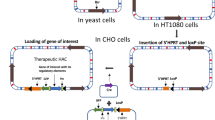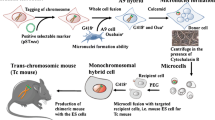Abstract.
Mammalian artificial chromosomes (MACs) are safe, stable, non-integrating genetic vectors with almost unlimited therapeutic transgene-carrying capacity. The combination of MAC and stem cell technologies offers a new strategy for stem cell-based therapy, the efficacy of which was confirmed and validated by using a mouse model of a devastating monogenic disease, galactocerebrosidase deficiency (Krabbe’s disease). Therapeutic MACs were generated by sequence-specific loading of galactocerebrosidase transgenes into a platform MAC, and stable, pluripotent mouse embryonic stem cell lines were established with these chromosomes. The transgenic stem cells were thoroughly characterized and used to produce chimeric mice on the mutant genetic background. The lifespan of these chimeras was increased twofold, verifying the feasibility of the development of MAC-stem cell systems for the delivery of therapeutic genes in stem cells to treat genetic diseases and cancers, and to produce cell types for cell replacement therapies.
Similar content being viewed by others
Author information
Authors and Affiliations
Corresponding author
Additional information
Received 29 July 2008; received after revision 22 September 2008; accepted 24 September 2008
Rights and permissions
About this article
Cite this article
Katona, R.L., Sinkó, I., Holló, G. et al. A combined artificial chromosome-stem cell therapy method in a model experiment aimed at the treatment of Krabbe’s disease in the Twitcher mouse. Cell. Mol. Life Sci. 65, 3830–3838 (2008). https://doi.org/10.1007/s00018-008-8442-2
Published:
Issue Date:
DOI: https://doi.org/10.1007/s00018-008-8442-2




